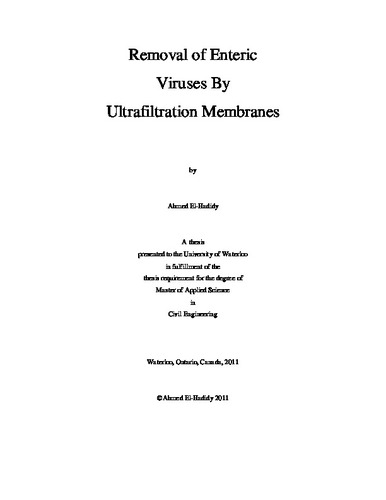| dc.description.abstract | Application of low pressure membranes in drinking water treatment, including both microfiltration (MF) and ultrafiltration (UF), have witnessed a rapid increase in the past decades. Low pressure membranes are considered a good technology in retrofitting existing conventional drinking water treatment plants or in newly constructed plants to meet the stringent regulations for drinking water treatment that aim at preventing health risks of waterborne diseases. Enteric viruses are one of the major types of waterborne pathogens, and they can be commonly found and are persistent in the environment. Both the United States and Canada require a 99.99% (4-log) removal of viruses during the drinking water treatment train.
Unlike MF membranes, UF membranes have a very good potential for removing enteric viruses from the water due to their smaller pores comparable to the size of viruses. Drinking water regulations/guidelines in both the United States and Canada do not grant UF membranes any removal credit for viruses by default; however they have the provision that, in certain cases, virus removal credit may be granted based on pilot scale challenge testing. A better understanding of the interaction between the UF membranes and virus rejection can help to establish a removal credit for UF membranes. An essential part of this will be the effect of the membrane operation on the rejection of viruses to determine if UF membranes can offer a consistent removal of viruses. Membrane fouling is one of the major problems in membrane operation and it can affect the rejection characteristics of the membrane and improve its performance.
The aim of this study was to investigate the removal of virus surrogates (MS2 and φX174 bacteriophage) using a commercial UF membrane under different conditions, to obtain information about the removal mechanisms of viruses. The experimental filtration unit was designed to have similar conditions like the full scale membrane treatment plants. The UF membrane used in this study provided very good removal of both MS2 and φX174 bacteriophage. The obtained results were consistent and in agreement with the expected removals based on the membrane characterization results and types of virus surrogate. As part of this work, a detailed study to improve methods for characterizing the pore size distribution of membranes was conducted.
In the second part of the study, two different types of surface waters were used to study the effect of membrane fouling on virus removal. It was found that mainly hydraulically irreversible fouling could significantly improve the virus removal by UF membranes. Different cleaning regimes that are used in treatment plants had varying effects on virus removal. After maintenance cleaning, virus removal remained higher than that of clean membranes, and only chemical cleaning was effective for completely removing membrane foulants and returning virus removal back to base levels. Advanced analytical techniques were used to define the nature of the fouling layer on the membrane surface and how the foulants affected the rejection of viruses.
Finally, our study showed that UF membranes are a robust treatment technology for removing different types of enteric virus surrogates from water under different operational conditions. Close monitoring of the UF unit performance and direct integrity testing can possibly detect membrane problems that can affect the rejection of viruses. Based on the virus physical characteristics and a detailed study of the membrane surface characteristics, especially the pore size distribution of the membrane, the removal of the specific virus can be closely estimated. | en |

